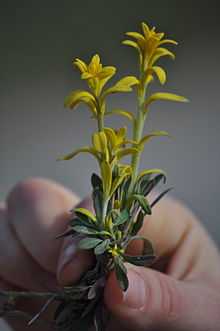Puccinia monoica
| Puccinia monoica | |
|---|---|
 | |
| Puccinia pseudoflowers produced on Arabis | |
| Scientific classification | |
| Kingdom: | Fungi |
| Phylum: | Basidiomycota |
| Class: | Urediniomycetes |
| Subclass: | Incertae sedis |
| Order: | Uredinales |
| Family: | Pucciniaceae |
| Genus: | Puccinia |
| Species: | Puccinia monoica |
Puccinia monoica is a rust fungus of the genus Puccinia that inhibits flowering in its host plant (usually an Arabis species) and transforms host behaviour in order to facilitate sexual reproduction of the rust fungus.
Life Cycle
Infection of the host mustard (usually Arabis) plants occurs via wind-borne basidiospores in late summer. Upon germination of the spores, fungal hyphae penetrate the stem of the mustard plant, siphoning off nutrients from its host. However, to reproduce, the fungus must undergo sexual reproduction, facilitated by the transfer of spermatia from the spermatogonia on this plant to receptive hyphae borne in the spermatogonia on another infected mustard plant. To accomplish this the fungus sterilizes the host plant, preventing it from producing true flowers. Instead, the fungus forces the infected plant to turn clusters of its leaves into brilliant yellow spring "pseudoflowers", bearing the spermatogonia. Insects visiting the pseudoflowers transfer spermatia from one host plant to another, in the same way that pollinators transfer pollen amongst the true flowers of uninfected plants.
Spermatia transferred in this way, will fuse with receptive spermatogonial hyphae on the recipient plant. The resulting hyphae subsequently form aecia. At this time, the pseudoflowers lose their green colour and stop producing nectar. Spores produced in the aecia are referred to as aeciospores and are responsible for infecting the alternate host plant (a grass species: Koeleria, Trisetum, or Stipa).
Upon germination hyphae produced by the aeciospores will penetrate the grass, leading to the production of uredia. The uredia produce urediniospores capable of infecting more grass plants. Ultimately, telia will be produced on the infected grasses. This leads to production of basidia and basidiospores. When released the basidiospores may infect new mustard plants, completing the life cycle.[1]
The Pseudoflowers
These flowers mimic those of yellow, early spring wildflowers (e.g. buttercups), not only in visible light but also in ultraviolet.[2] Since bees "see" in the ultraviolet range, these flowers are more attractive to the pollinating insects. In addition, the fungus produces a distinct scent to attract insects; this olfactory appeal has allowed the fungus to evolve and "improve" upon the mimicry system by facilitating proper transfer of fungal spermatia.[3] The bees feed on a sweet, sticky substance that the fungus forces the plant to produce on the imitation flowers.[4]
Taxonomy and Life Cycle Variation
Researchers have noted that Puccinia monoica is one species of a complex of closely related species, which show considerable variation with regard to hosts and life cycle.[5] Puccinia monoica has a life cycle involving two alternate hosts (a mustard and a grass), whereas others species may not. The Puccinia monoica life cycle is macrocyclic, including the production of basidia, telia, spermatia, aecia, and uredia. In contrast Puccinia thlaspeos also produces pseudoflowers, but has no aecia or uredia phase, completing its entire life cycle on Arabis.[6]
See also
References
- ↑ Roy, BA (1993) Patterns of Rust Infection as a Function of Host Genetic Diversity and Host Density in Natural Populations of the Apomictic Crucifer, Arabis holboellii. Evolution 47: 111-124.
- ↑ Roy BA (1993) Floral mimicry by a plant pathogen. Nature 362:56–58
- ↑ Roy, B.A. and Raguso, R.A. Olfactory versus visual cues in a floral mimicry system. Oecologia, V. 109, No. 3: 414-426
- ↑ Zimmer, C. Parasite Rex: Inside the Bizarre World of Nature's Most Dangerous Creatures.
- ↑ Roy, B.A., Vogler, D.R., Burns, T.D. & Szaro, T.M. (1998). Cryptic species in the Puccinia monoica complex. Mycologia, V. 90, No. 5: 846-853
- ↑ Roy, BA (1993) Patterns of Rust Infection as a Function of Host Genetic Diversity and Host Density in Natural Populations of the Apomictic Crucifer, Arabis holboellii. Evolution 47: 111-124.